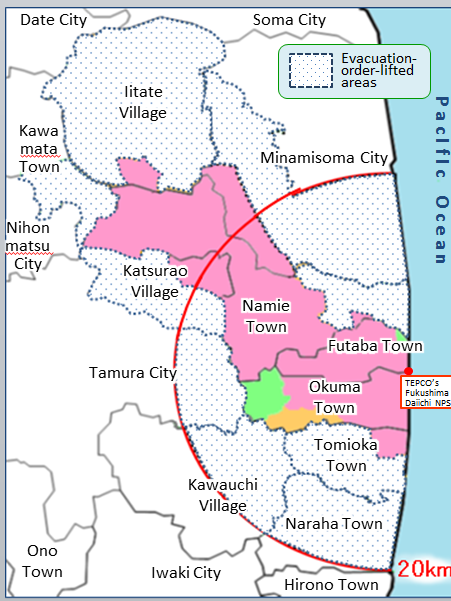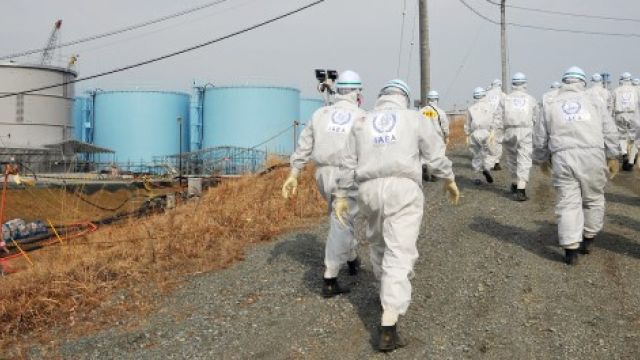
10 Years of Fukushima Part 2: Radiological consequences
Triggered by the Tōhoku earthquake and the subsequent tsunami, a catastrophic accident occurred at the Fukushima Daichii nuclear power plant on 11 March 2011, resulting in massive releases of radioactivity - mainly from Units 1, 2 and 3, which suffered core meltdowns. Along with Chernobyl, Fukushima is the most severe accident in the history of nuclear power; both were classified as a "major accident" at Level 7, the highest level on the international INES rating scale (for more on the classification, see our interview with Michael Maqua, the German INES officer). From a radiological point of view, the main difference between the two events is that, on the one hand, the radioactivity at Chernobyl was spread over a much larger area. On the other hand, the amount of radioactivity released at Fukushima was "only" about ten percent of that at Chernobyl. Exactly how much radioactivity was ultimately released can only be roughly estimated, partly because the measuring devices installed on site failed due to the earthquake and the subsequent tsunami.
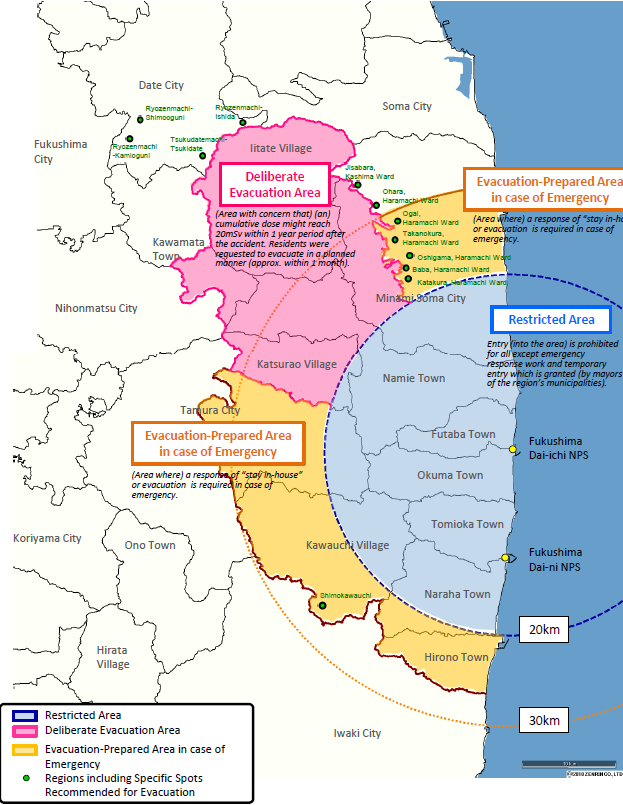
The type of substances released in the two accidents also differs to some extent. At Fukushima, it was mainly the highly volatile radionuclides iodine-131, caesium-134 and caesium-137 that escaped from the badly damaged reactors as radioactive aerosols and gases, especially in the first days of the accident, and were carried away by the wind. As the wind was mostly blowing seaward in the first days, a large part of the radioactivity reached the Pacific. But the plant site and the rural surroundings were also contaminated, especially on 15 and 16 March, when the wind blew increasingly from a south-easterly direction. Intensified by rainfall, large amounts of radioactive materials were deposited in an area extending up to several dozen kilometres from the site in a northwesterly direction. The Japanese authorities gradually evacuated the area up to a radius of 20 kilometres and some areas beyond.
Radiological situation on the plant site
However, it was the plant site that was most affected. Two phases can be distinguished here.
In the first phase until about the end of March 2011, very high radiation levels were measured again and again. Especially in the first days, peak values of the local dose rate (LDR) of up to 12 millisieverts per hour occurred - in this case, the legal annual limit for the radiation dose of an occupationally exposed individual would already have been reached after about 100 minutes. Since the measuring devices installed on site failed, the LDR was measured by mobile measuring stations (mainly measuring vehicles) that changed their position several times. The reason for the high LDR values in this phase was primarily the release of radioactive substances into the ambient air. Some of the radioactive substances released into the air were deposited in the surrounding area and thus increased the LDR on the plant site. Due to the high radiation levels, the emergency forces were only able to work on the site for a very limited period of time and with the appropriate protective equipment. In the further course, so-called hotspots with LDR values of up to 10 Sv/h were discovered outside the reactor buildings at contaminated parts of the plant, which made work at the affected sites even more difficult.
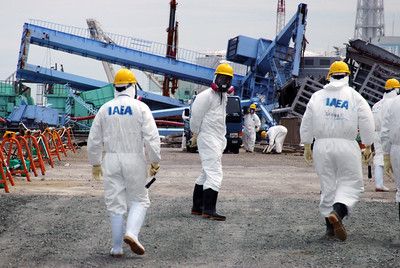
After the very high radiation levels measured in the first weeks, the LDR on the site initially dropped sharply in the second phase. On the one hand, this was due to the fact that the decontamination measures, such as the removal of particularly radioactively contaminated debris, took effect; on the other hand, the radioactive iodine, due to its relatively short half-life of about eight days, only contributed significantly to the radiation exposure in the first weeks. Today, it is sufficient to wear a dust mask to enter most of the site. However, the LDR values in and immediately around reactor Units 1 to 3 are still significantly higher, so that more extensive protection is required there.
Radioactivity entering the sea
In addition to the air, a considerable amount of radioactivity was released into the environment through the water. On the one hand, this came from destroyed pipes; on the other hand, since 12 March 2011 to this day, water has been continuously pumped into the reactor vessels from outside for cooling. The highly contaminated water emerged from the reactor buildings in large quantities and was quickly stored in large tanks on the site. In the first few years, there were isolated leaks in the tanks through which contaminated water leaked into the surrounding area. Contaminated water escaped from the reactor cores of Units 1, 2 and 3 or from the tanks via the groundwater into the Pacific Ocean, but to a much lesser extent. Appropriate measures such as sheet pile walls, pumps or the so-called ice wall minimise the entry into the Pacific and only low levels are measured in the seawater at the plant (a separate article on the water problem will be published in this series on Fukushima).
The activity concentrations in the seawater rose sharply, especially in the period shortly after the accident, when large quantities of contaminated water entered the Pacific in an uncontrolled manner. In addition to caesium and iodine, other radioactive substances such as strontium and tritium also entered the sea. Due to dilution in the seawater, the increased activity concentrations were limited to the immediate vicinity of the plant. The harbour basin was sealed with a layer of concrete because larger quantities of the radioactive substances were deposited in the seabed by sedimentation. Even today, the radioactivity concentration in the harbour basin and at sea is checked by regular measurements.
According to the International Atomic Energy Agency (IAEA), this is the largest release of radionuclides into an ocean caused by an accident to date. This sometimes led to greatly increased activity concentrations in fish and seafood, some of which were well above the limits. Fish and seafood from the region were therefore no longer allowed to be sold. Today, concentrations of radionuclides above the legal limits are only measured in far less than one per thousand of the several thousand samples tested by the Japanese Ministry of Health each year.
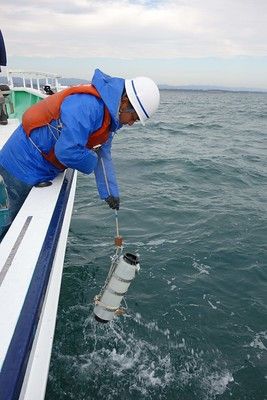
Laut Angaben der Internationalen Atomenergie-Organisation (IAEO) handelt es sich um die bislang größte durch einen Unfall verursachte Freisetzung von Radionukliden in einen Ozean. Das führte mitunter zu stark erhöhten Aktivitätskonzentrationen in Fischen und Meeresfrüchten, die teilweise deutlich über den Grenzwerten lagen. Fische und Meeresfrüchte aus der Region durften daher nicht mehr verkauft werden. Inzwischen werden nur noch bei weit unter einem Promille der mehreren tausend Proben, die vom japanischen Gesundheitsministerium pro Jahr getestet werden, Konzentrationswerte von Radionukliden über den gesetzlichen Grenzwerten gemessen.
According to the International Atomic Energy Agency (IAEA), this is the largest release of radionuclides into an ocean caused by an accident to date. This sometimes led to greatly increased activity concentrations in fish and seafood, some of which were well above the limits. Fish and seafood from the region were therefore no longer allowed to be sold. Today, concentrations of radionuclides above the legal limits are only measured in far less than one per thousand of the several thousand samples tested by the Japanese Ministry of Health each year.
Short- and long-term health effects
As a result of increased radiation exposure, two different types of health damage can basically occur.
The so-called deterministic damage is commonly summarised under the term radiation sickness. They usually occur in the short term and only above a threshold value in the order of 500 millisieverts (mSv). This corresponds approximately to 50,000 times the dose of an X-ray of the chest. Depending on the radiation dose, typical symptoms include reddening of the skin, headaches, nausea, vomiting, or hair loss. At a threshold value of around 6,000 mSv, radiation exposure inevitably leads to death. In the case of deterministic damage, the following applies: the higher the radiation dose, the more severe the radiation damage.
The so-called stochastic damage can already be caused by lower doses. The radiation causes damage to the DNA, i.e. the genetic material, which can, for example, trigger cancer or lead to hereditary damage. Since stochastic damage does not occur directly after exposure to ionising radiation, but only increases the risk of disease, it is much more difficult to detect. A connection between radiation exposure and disease can only be proven statistically and only above a dose of about 100 mSv. Unlike deterministic damage, the severity of the damage does not increase with the radiation dose - but the statistical risk of falling ill increases.
Health effects for the emergency workers on the plant site
Unlike at Chernobyl, no direct radiation-related deaths were reported. Nevertheless, especially in the first few weeks, many workers were exposed to doses that exceeded the legal limits many times over. According to TEPCO, by the end of March, 80 of its own employees and 19 employees of external companies had been exposed to radiation doses of over 100 mSv, 6 of them over 250 mSv. For comparison: the limit in Germany for the general population is 1 mSv per year, for occupationally exposed individuals it is 20 mSv, and in emergencies the reference value of 100 mSv should not be exceeded. The occupational lifetime dose must not exceed 400 mSv.
A study by the World Health Organisation (WHO) concludes that workers who have been exposed to an increased dose have a higher risk of cancer than the population average. A study by the United Nations Scientific Committee on the Effects of Atomic Radiation (UNSCEAR) expects no significant increase in cancer risk for the 99 % of workers who received an effective dose of less than 100 mSv. For the remaining almost 1 %, a slightly increased cancer risk is expected.
Health effects for the population
In the course of the emergency measures, the authorities evacuated the first affected areas in the immediate vicinity of the plant as early as in the evening of 11 March; according to the Japanese government, about 62,000 people were evacuated, a total of about 146,500 by 13 March. Some areas were completely evacuated, in others children, pregnant women and sick people were advised to stay away. Elsewhere, nurseries and schools were closed and people were advised to leave the zone voluntarily.
As a result of the evacuations, people outside the plant were exposed to quite low radiation doses. Since the statistical detectability of radiation damage also decreases with the low radiation doses, it is fundamentally difficult to quantify the health effects for the population. The WHO study mentioned above assumes that due to the overall low radiation doses, no stochastic effects such as increased cancer rates or an increase in infant mortality, miscarriages, congenital malformations or developmental disorders are to be expected. However, in the most severely affected areas, slight increases in the risk of certain types of cancer are to be expected, depending on the age group and gender.
For the village of Namie, for example, one of the most severely affected areas within Fukushima Prefecture, the WHO estimates that the relative leukaemia risk for young children will increase by about 7 %. This means that the spontaneous leukaemia rate, which was 0.60 % (1-year-old boy) and 0.43 % (1-year-old girl) in Japan before the accident, increases to about 0.64 % (1-year-old boy) and 0.46 % (1-year-old girl). For the development of thyroid cancer, the probability of developing the disease for a woman exposed as a young child is expected to increase from 0.77% to 1.29% for Namie village. This corresponds to a relative increase of 70 %. For boys, the incidence rate is expected to increase from 0.21 % to 0.33 %. The extent to which these figures are accurate and how exactly radiation doses affect the development of (thyroid) cancer has been the subject of repeated controversial scientific discussions in recent years.
Even if the figures of the major studies by the WHO, the IAEA or UNSCEAR come up with largely similar orders of magnitude, they are not undisputed - other publications, for example by various non-governmental organisations, arrive at values that are in part significantly higher, especially for stochastic cancer and cancer deaths. These different assessments between international institutions and non-governmental organisations illustrate how difficult it is to determine and assess stochastic damage. (For more on this, see the interview with Thorsten Stahl, Radiation Protection Supervisor and Head of the Radiation Protection Department at GRS.)
In order to be able to analyse and assess the long-term radiation damage, the Radiation Medical Center for the Fukushima Health Management Survey has been conducting studies in a broad-based monitoring programme, in which more than two million Japanese citizens are being examined, since September 2011. After more general surveys, the so-called Detailed Surveys were followed by more specific examinations, focusing on the thyroid gland, pregnancies and births or mental health, which are still ongoing today.
Victims of evacuation and psychosocial damage
Even though no short-term health damage occurred in the general population and no significantly increased cancer risk is to be expected, at least according to the WHO, UNSCEAR and others, the accident nevertheless caused a large number of fatalities and a wide range of health damage.
However, it should not be forgotten that a so-called triple disaster occurred in Japan in March 2011 and that the strongest earthquake in Japan since the beginning of earthquake records there and the tsunami triggered by it had devastating effects, of which the nuclear disaster in Fukushima is only one aspect. It is not possible to draw a clear dividing line between the victims of the NPP accident on the one hand and the natural disaster on the other.
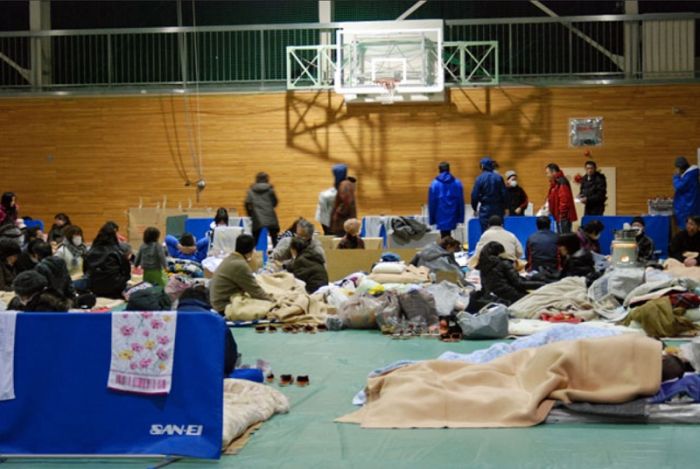
According to the UNSCEAR study, as a result of the evacuation measures, more than 50 hospitalised patients died from hyperthermia, dehydration or the worsening of underlying medical problems, and probably another more than 100 elderly people died in the following months from a variety of causes related to the evacuation. Evacuees were forced to move into emergency shelters (gymnasiums, temporary container housing), and in some cases entire towns were relocated. Some scientific studies assume several hundred deaths in the course of the evacuation measures.
In addition to the physical damage, various studies show a number of cases of psychosocial damage caused by the accident and its consequences. For example, the number of mental illnesses and the number of people with sleep disorders among those affected increased by a factor of about 5 compared to the Japanese average. Likewise, obesity and diabetes rates increased significantly. The death rate among evacuated seniors increased by a factor of three in the first months compared to Japan as a whole and later decreased to a factor of 1.5. Media also report about young people having difficulties finding partners, about bullied schoolchildren as well as about increased suicide rates.
Accordingly, previous evaluations of the Japanese monitoring programme have also come to the conclusion that although hardly any radiological effects are visible, the psychosocial damage triggered by the events causes all the more suffering, especially in the long term. Similar findings were made at Chernobyl, even though both the deterministic and the stochastic radiation damage were significantly more dramatic.
Ecological, social and economic consequences for the affected regions
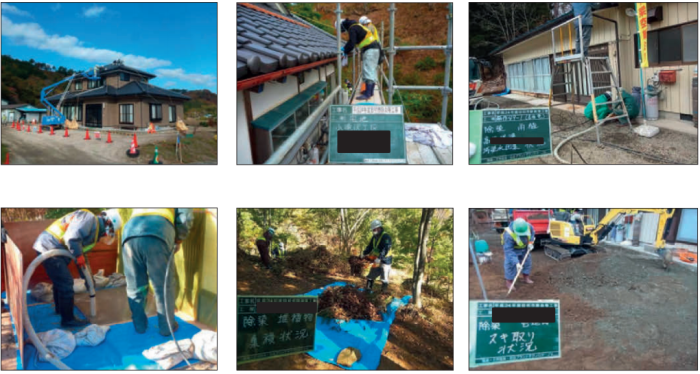
In addition to these health effects, the region has to deal with a number of ecological and economic consequences. These consequences in turn affect the lives of the people who have or had their homes in the affected regions of Fukushima prefecture. Although most of the evacuees have now been able to return home, there are still areas that cannot yet be resettled due to the high levels of radiation, despite extensive decontamination measures. Over the years, painstaking work has been carried out to remove several centimetres of topsoil, collect leaves, and clean roofs and streets with high-pressure cleaners. However, the forests and fields are even more contaminated because the clean-up teams were not able to clean every square metre.
Agriculture and fisheries are also affected. First, hundreds of thousands of animals left behind starved to death because of the sudden evacuation. Some of the agricultural and marine products exceeded the limits for radioactivity in Japan in the measurements taken to monitor the food and were not allowed to be sold. Even though hardly any food from the region exceeds the limits today, regional agriculture and fisheries are still struggling with the damage to their image. Some countries and regions still restrict the import of products from around the affected regions.
This summer, the Japanese government wants to commemorate the victims and celebrate the reconstruction with the Summer Olympics. The Games of Recovery are intended to put an end to the damage to the image of the Fukushima region by showing the world that the radiological situation has meanwhile eased. Fukushima would not only be the venue for baseball and softball games - the symbolic torch relay would also start here. But on the one hand, it is unclear whether and under what conditions the games can take place in times of Corona. On the other hand, there is resistance, especially from NGO and population circles, against an alleged normality in areas where elevated radiation levels are still measured at hotspots.
